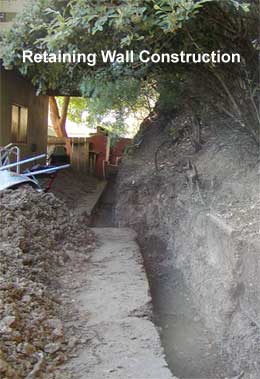Summary: Garden, landscape and yard drainage solutions come in many shapes and sizes. In this article we’ll look at a number of drainage issues readers have asked about and potential solutions to their water drainage problems.
Garden Drainage Solutions – Preventing Water Standing on Steps

Question: Our backyard has some old steps which constantly have watering sitting on them.
Is there anyway we can fix the drainage problem on the landscape steps without totally ripping them out and starting over? Colleen, Michigan
Answer: Colleen, if water lies on steps because no wash has been provided, it may be possible to build up the steps with concrete colored to match the existing material.
Do the work carefully, to be sure that it does not look patched.
Don’t finish the job until you have allowed a little of the new, colored concrete to dry; it is hard to tell when it is wet whether it will be a good match.
If the trouble is a depression worn by time in a patch of soft natural rock, you may have to replace the slab, or to raise it and turn it over.
When a retaining wall is becoming weakened because there is no way for water to escape, it is usually best to call in an expert to find out if and how the situation can be corrected.
Yard Drainage Solutions – Improving Clay Water-Logged Soil
Question: The clay type soil in our front yard is always water-logged, what can we do to help get rid of the water and provide better yard drainage for the plants in our front yard? They always seem to have trouble growing from too much “wet.” JoLeen, Brentwood, Tennessee
Answer: JoLeen, soil may retain water beyond the point of safety for a number of plants because of:
- Its intrinsic character
- Hardpan or some other impervious condition just below the surface
- A grading condition that causes water from a higher level to accumulate
When poor porosity is caused by heavy, clayey soil, the remedy is to use plenty of soil conditioners, such as sand, peat moss, and lime, and to work them into the soil until a satisfactory consistency has been obtained.
The Hardpan Like Cement
Hardpan is a hardened or cemented layer of soil, which may occur at any depth below the surface. It creates much more of a problem than soil that is merely heavy.
Tnswer may be to grow mainly plants that don’t mind wet feet, or that are so shallow-rooted that they will not be troubled by poor drainage below the surface.

For plants that demand good drainage, treat isolated areas by breaking up the hardpan and getting a good depth of well-drained soil.
Roses, for instance, must have good deep drainage.
If there is any doubt at all about the subsoil conditions in your garden, apply the rough and ready test for digging a hole about eighteen inches deep and filling it with water.
No two people agree on how quickly the hole should be empty.
I would feel uneasy if it were not empty in an hour, but in hot dry areas slow drainage may be an advantage.
The point is that for most plants the water must drain out. Even in gardens where the drainage is generally good, there may be isolated pockets of stagnation caused by a buried boulder or slab of stone.
So it is really always wise to be on guard when planting fairly deep-rooted material that will be injured by excessive water.
Water Accumulation
The accumulation of water in a low-lying area often calls for subterranean drainage of some kind.

It is best to consult a local expert, get info from the library or talk with the State Agricultural Extension Service in your area information about the various methods of constructing sub-surface drainage systems. These are not necessarily complicated.
At the opposite end of the scale from water-logged soil is the condition in which water drains too freely. If this is due to the quality of the soil, work in water-holding materials.
In conclusion, don’t forget that there are plants for almost every kind of situation.
If you don’t want to drain the bog, make a bog garden; and if you prefer not to recondition a patch of super-porosity, study the flora of the desert and the dunes. Whether you bend with the wind, or resist its direction, is partly up to you.
Landscape Drainage Solutions: Old Houses – Don’t Be Too Impulsive
Question: Our old house has paving right up next to one of the walls and wanted to know if there are any potential drainage problems we could face if we remove the paving and plant some shrubs next to the house? Lee, Norfolk, Virginia
Answer: Lee, in an old house, when there is existing paving right up to the walls of the house.
Don’t be too impulsive about removing the paving to make planting areas. Remove one or two slabs and check the situation by pouring a few pails of water into the exposed earth.
If there is a potential problem, leave the paving to protect the walls and either plant in movable containers, or wall in a planting area on top of the paving.
Put plenty of stones or other drainage material at the bottom of the walled-in area, and provide holes at the base for water to drain out onto the exposed paving away from the house.



Comments on this entry are closed.